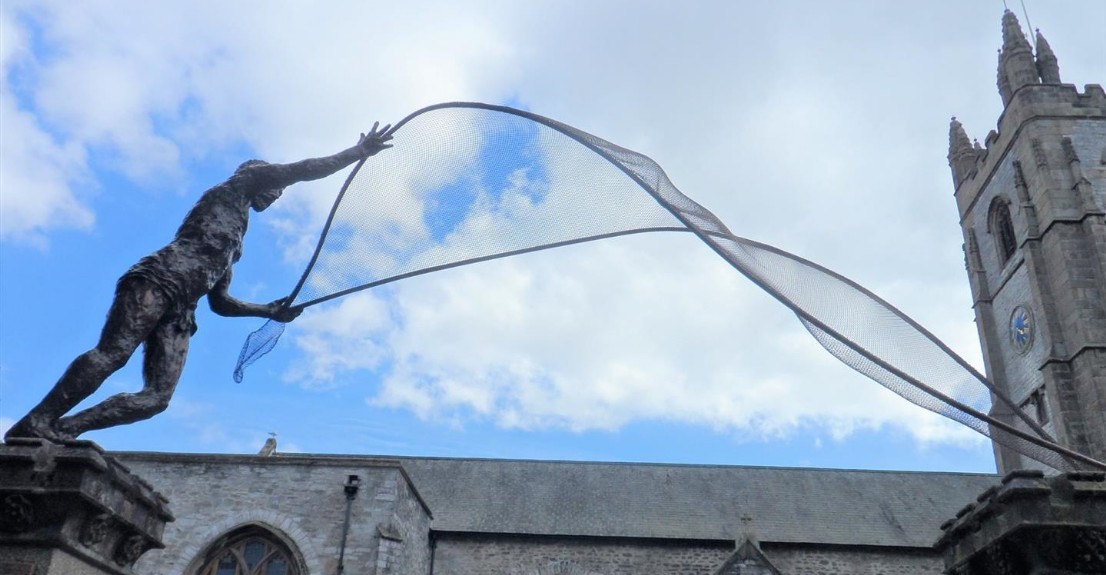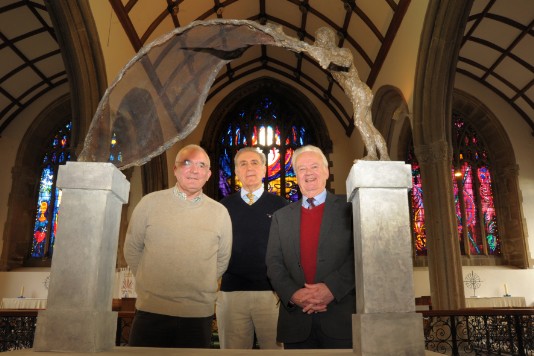Saint Andrew, Fisher of Men
A sculpture for the Minster Church of St. Andrew, Plymouth.

This exciting commission was for a sculpture on the pillars (which stand 91" high) on the boundary of the public open space in front of St. Andrew's Minster, at the entrance to the thoroughfare that links the city with the church.
My idea was for a figure of St. Andrew throwing a casting net across the pillars and so forming an arch. There was the potential for a great deal of rhythm and movement within the work, and as one moves around it, every changing aspect should reinforce the sense of a net being thrown. in Christian terms, the net is cast across all those people passing beneath it, reflecting St. Andrew’s role as a “fisher of men”, involving people consciously or unconsciously in its symbolism, and therefore reflecting the redemptive significance of the Christian presence. Where the front and back edges of the net cross, the lines formed suggest both the Christian fish symbol and the saltire (the St. Andrew's cross). . It therefore prefigures St. Andrew’s martyrdom.
Immediately behind the pillars, the single word resurgam (I will rise again) is inscribed in stone above the north door of the Minster. It marks the position of a board, bearing the same word, which was placed there during the war shortly after the church was bombed; a moving expression of the hope, both Christian and temporal that church and city would rise again from the devastation inflicted by the blitz. It is my hope that the rise of the net at the summit of its arch will be suggestive of that concept, which would also widen the sculpture’s meaning for a broader public. Similarly, St. Andrew, as a fisherman, has a general significance in representing the historic and contemporary importance of Plymouth as a fishing port.
When I made my original site visit, I went into the new town opposite the church as well as to the older parts in order to try to get a feeling for the city as a whole, and was struck by the similarities and differences both actually and historically with Harlow New Town, built within 5 miles of my Much Hadham home just after the war, to house evacuees from the blitz in London. The big difference is that in Harlow, the new and old towns are quite separate because there was little local bombing and the new town was built on a green-field site. In Plymouth, one of the interesting things is the interrelation of the two - the merchant's house set amongst modern buildings; a bombed church oturned into a memorial roundabout; and the totally different aspect looking away from St. Andrew's into the town from looking away from the town towards St. Andrew's. It occurred to me that an arch across the pillars would be a significant way of relating the different aspects of the city and accentuating the importance of continuing history. An arch both divides and joins; it is always both a crossing place and a meeting point. Visually, as one stands at the pillars it lies between the old and the new, with their different but related histories, as well as between the specifically Christian and the more general communities. Combined with the fishing element, I believe that gives the sculpture a relevance which is very specific to a city that in a quite extraordinary sense combines the contemporary with its own history.



The maquette with the leaders of the art commissioning group, (from left to right) David Kay, Jack Spence and Alun Hughes (chairman)
To see the stages in the productioin of this sculpture, click here.

